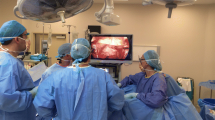Abstract
Background: In video-assisted laparoscopy, the image is usually displayed on a monitor placed at approximately eye level. Video projection systems project the image onto a screen placed close to the hands. This is said to be ergonomically superior. To evaluate this approach, a proprietary projection system (PS) was compared to a monitor display (MD). Method: The resolution, ghosting, flickering, glare, contrast, color smear, and color matching of the two modalities were compared. A bowel-suturing task was employed to evaluate performance differences. Results: The image displayed by the first-generation PS is inferior to that of the MD in contrast and resolution measures, but it is comparable in the other image qualities. No significant differences in task performance were identified. Conclusions: The first-generation PS does not confer performance or comfort advantages over an MD. The theoretical advantages of the gaze-down stance are likely to be realized only if a high-quality projector is used.
Similar content being viewed by others
Author information
Authors and Affiliations
Rights and permissions
About this article
Cite this article
Brown, S., Frank, T., Shallaly, G. et al. Comparison of conventional and gaze-down imaging in laparoscopic task performance. Surg Endosc 17, 586–590 (2003). https://doi.org/10.1007/s00464-002-8525-3
Received:
Accepted:
Published:
Issue Date:
DOI: https://doi.org/10.1007/s00464-002-8525-3




